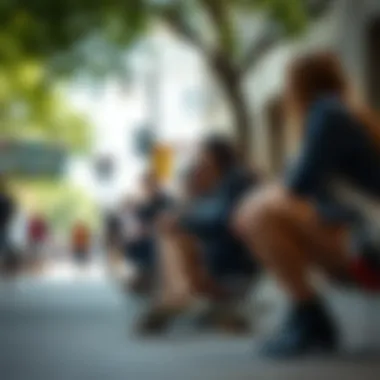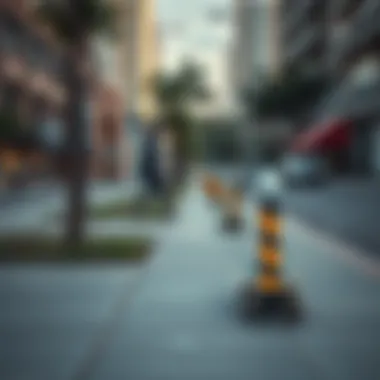Skateboard Deterrents on Sidewalks: An In-depth Study


Intro
Skateboarding is not just a mode of transport for many; it’s a culture, an art form, and a form of self-expression. However, in urban settings, the presence of skateboarders often brings about collisions with public safety and community preferences. Sidewalks have occasionally turned into the main stage for skateboard tricks, prompting a reaction from city planners and local residents alike. This dynamic creates a conversation about skateboard deterrents—a crucial topic at the intersection of urban design and community needs.
The need for skateboard deterrents often emerges in spaces where the lines between public access and private experience are blurred. While some view skateboarders as disruptive mischief-makers, others recognize them as a vibrant part of city life. As sidewalks become a canvas for young skaters, the pressing question arises: how can we create environments that respect both the freedom of expression inherent in skateboarding and the needs of the community?
In this article, we’ll dissect the various deterrents employed in urban environments, examining their effectiveness and the broader social implications. By delving into types, community feedback, and potential alternatives, we aim to provide insights that are valuable not only for stakeholders like city planners and skateboard enthusiasts but also for parents whose concerns about safety may influence the future landscape of skateboarding in public spaces.
Join us as we navigate the intricate web of skateboarding culture, urban design, and community safety in our exploration of skateboard deterrents on sidewalks.
Skateboarding Techniques
Skateboarding may look effortless to the untrained eye, but mastering it requires dedication and a true understanding of technique. For both casual riders and determined enthusiasts, grasping the fundamentals can enhance the experience tremendously.
Mastering the Basics
Before diving into more complex maneuvers, a strong foundation is necessary. Beginner skaters often focus on essential skills such as:
- Pushing Off: Learning how to gain speed effectively is critical. Skaters typically practice pushing with one foot while balancing on the board.
- Turning: Regulation of the board's direction can make or break a skater’s ability to navigate crowded sidewalks.
- Stopping Safely: Knowing how to come to a stop is essential—whether it’s through dragging a foot or learning the heel drag method.
Learning these tricks takes patience, but the payoff can be significant. A well-practiced technique allows skaters to feel confident as they hit the streets.
Advanced Tricks and Stunts
Once skaters have solidified their foundational skills, it’s time to take it a notch higher. Advanced tricks aren’t merely flashy; they demonstrate a skater’s finesse and mastery. Some popular ones include:
- Ollie: The basic leap that forms the basis for nearly every skateboarding trick.
- Kickflip: An essential skateboarding maneuver where the board flips beneath the rider’s feet.
- Grind: Sliding along edges or rails adds style and shows control.
These techniques often serve as crowd-pleasers, yet public spaces may not be suited for their execution, causing tension with pedestrian traffic and local authorities.
"Skateboarding isn't just about movement; it’s a dialogue between the rider and the environment."
By mastering different techniques, skaters can better understand their capabilities and the limitations and preferences of their surroundings, leading to a more harmonious urban skate culture.
Gear and Equipment
To enhance performance and safety, having the right gear is crucial. Each element plays an important role in shaping a skater's experience.
Skateboard Types and Features
Not all skateboards are created equal. Each type serves a different purpose and caters to various styles:
- Street Skateboards: Compact and sturdy, perfect for doing tricks. They come with a non-slip grip tape.
- Longboards: These are longer and more stable, often preferred for cruising and downhill rides.
- Cruisers: Excellent for easy mobility around urban environments, providing a smooth ride.
Choosing the right skateboard can affect both the performance and the sensation of riding. Each type caters to different skills and preferences.
Essential Safety Gear
Safety should never be an afterthought. Proper gear minimizes injury risk significantly, especially in busy spaces like sidewalks. Essential equipment includes:
- Helmets: Protect the noggin—especially vital for beginners or those learning new tricks.
- Knee and Elbow Pads: They provide extra cushioning against falls.
- Skate Shoes: Designed for optimal grip and support while skating.
It’s clear that while the excitement of skateboarding is undeniable, taking safety precautions is a significant part of enjoying the ride.
Understanding both the techniques of skateboarding and the gear needed to enjoy it responsibly is crucial for skaters, parents, and city planners alike. As communities shift towards more inclusive urban designs, finding solutions that embrace skate culture while maintaining public safety will remain vital.
Understanding Skateboarding Culture
Skateboarding is more than just a hobby or a sport; it's a multifaceted culture that intertwines passion, creativity, and identity. Understanding this culture is crucial to grasping the implications of skateboard deterrents on sidewalks. Many skateboarders view their boards as extensions of themselves. The community fosters a unique bond among enthusiasts, characterized by shared experiences and styles. Recognizing these nuances allows urban planners to develop better solutions that respect both the skaters and the pedestrians.
The Rise of Skateboarding
The surge in skateboarding gained momentum during the late 20th century, carving its niche as an influential form of self-expression. Initially, especially among youth, it began as a way to pass the time, often seen in suburban streets or empty parking lots. Over the years, it morphed into a global phenomenon, complete with major competitions, sponsorship deals, and a distinct lifestyle. The rise of social media in the 21st century has amplified this evolution; skateboarding videos go viral at the click of a button, further cementing its popularity. This shift transformed the skater's role within the community, turning amateurs into icons almost overnight.
Skateboarding as a Lifestyle
Skateboarding transcends mere tricks and flips. It's about embracing a mindset, a rebellious spirit against conformity. The skateboarder often reflects individuality, marked by unique styles, personalized boards, and a particular way of navigating the world. From urban settings to serene parks, skaters often possess a keen awareness of their surroundings, weaving through pedestrian traffic with agility. This lifestyle further underscores the significance of recognizing skateboard culture in urban planning, especially when discussing deterrents.
Engaging with skateboard culture doesn't just involve creating spaces for skating but also understanding the social dynamics at play. From skate parks to local shops, every element plays a role in fostering community ties. It's imperative to remember that while deterrents aim to ensure safety and accessibility, they can also unintentionally marginalize a culture rich with creativity and community.
"Understanding skateboarding culture is essential to ensure that deterrents do not curtail the spirit of the community they seek to regulate."
Taking a closer look at how society interprets skateboarding can influence urban design. By understanding skateboarders as integral players in the urban narrative, we can strike a balance that addresses safety while honoring the creativity, freedom, and ethos synonymous with skateboarding.


The Importance of Sidewalks in Urban Environments
Sidewalks are not mere strips of concrete running alongside our roadways; they are crucial corridors that facilitate movement, enhance safety, and foster community engagement in urban settings. When pondering skateboard deterrents, it becomes imperative to recognize the multifaceted role sidewalks play. They serve as pathways not just for pedestrians but also for skateboarders, joggers, and cyclists. With the population in urban areas continuing to burgeon, the function of sidewalks becomes ever more significant.
One cannot emphasize enough the safety considerations tied to sidewalks. Properly designed and maintained sidewalks offer a refuge for those traversing the streets, separating them from vehicular traffic. This buffering effect is foundational for accidents prevention, with studies indicating that wider sidewalks correlate with reduced pedestrian injuries and fatalities. In cities where the pavement is well-kept and free from obstructions, the likelihood of mishaps diminishes significantly, permitting smoother mobility.
To support these points, consider the following:
- Crime Prevention: Well-lit, frequently patrolled sidewalks can deter criminal activity, creating a feeling of security among users.
- Economic Activity: Walkable environments increase foot traffic to local businesses, providing a boost to the economy.
- Community Interaction: Sidewalks often serve as social venues where people engage, fostering a sense of belonging and community bonds.
In terms of skateboard deterrents, it’s critical to maintain a balance. While it’s important to ensure safety for all users, the amenities or hindrances placed on sidewalks should also take into account the diverse ways people want to engage with urban spaces.
Sidewalk Accessibility and Safety
Accessibility is a key element intertwined with sidewalk design. A well-planned sidewalk system accommodates users of all abilities, ensuring ramps for wheelchairs and strollers, clear signage, and minimal barriers. When ramps are poorly constructed or insufficiently placed, skateboards naturally become a nuisance as skaters often seek out these pathways for mobility or recreation.
Here are several factors that contribute to effective sidewalk accessibility:
- Surface Quality: Sidewalks should be free of cracks, potholes, or debris to maintain an even surface, which benefits skaters while also ensuring safety for pedestrians.
- Width and Layout: A spacious walkway allows for various types of movement while preventing bottlenecks and potential conflicts among users.
- Signage: Clear signage that indicates shared use can enhance safety and minimize accidents between different groups of road users.
Skateboarding in urban areas presents unique challenges regarding safety. For instance, while skateboarders often seek out smooth surfaces, their presence may deter those who do not share the enthusiasm for skates. Therefore, integrating measures that satisfy both skateboarders' needs and those of everyday pedestrians is vital in urban profitability and safety.
Usage Patterns and Urban Mobility
Understanding how sidewalks are used is essential for effective urban planning. Patterns differ greatly depending on the time of day, season, and specific location. For example, sidewalks near schools will experience surges during school start and end times; likewise, nightlife areas will draw foot traffic in the evenings. These dynamics are crucial when analyzing how skateboard deterrents impact various users.
A close look at usage patterns reveals several insights:
- Peak Times: During rush hours, sidewalks can become congested, suggesting that a high volume of skateboard users may exacerbate this issue.
- Demographics: Young adults and teenagers are often the most active skateboarders, indicating that design and deterrent strategies should reflect the needs of this demographic.
- Cultural Significance: In places where skateboarding is embraced, you might find cities promoting spaces that allow such activities rather than deterrents, effectively changing the landscape of urban mobility.
To accurately assess how sidewalks can cater to all, cities can implement pedestrian studies or surveys to gather data firsthand, understanding better how skateboarders interact with the space alongside others.
Common Skateboard Deterrents
Understanding the role of skateboard deterrents is crucial in developing strategies that respect both pedestrian safety and skateboarding culture. As skateboarding gains popularity in urban settings, finding effective deterrents becomes an important task for city planners and communities. The presence of skateboarders can sometimes lead to conflicts with pedestrians or damage to public spaces, making it vital to explore deterrent methods that address these challenges while fostering a balance in urban environments.
Physical Barriers
Metal Railings
Metal railings serve as a practical solution when it comes to deterring skateboarders in urban areas. They offer a physical boundary that prevents access to certain surfaces commonly skated upon, such as ledges or staircases. A key characteristic of metal railings is their durability. Unlike wooden barriers, they withstand wear and vandalism, making them a favored choice for city planners.
The unique feature of metal railings lies in their height and structure. They can be designed to discourage skating while still allowing pedestrians to move freely. One advantage is the visibility they provide – a well-placed railing can easily signal to skateboarders that an area is off-limits without causing obstruction to foot traffic. However, the downside is that they may create a less inviting space when overly utilized, potentially signaling disapproval of skateboarding culture altogether.
Planting and Landscaping
Using natural elements for deterrence, such as shrubs or other greenery, stands out as a more aesthetic approach. Planting and landscaping not only beautify urban spaces but also serve to disrupt the flow skateboarders might seek on a smooth surface. A key benefit of this method is that it softens the starkness of urban environments, making them more appealing to pedestrians and community members.
The unique characteristic of this deterrent is its dual purpose; while it can function effectively to prevent skating, it also enhances overall urban design. However, there's a downside – it requires maintenance and can attract litter, which might detract from public spaces if not properly cared for.
Street Furniture
Another effective deterrent is street furniture, such as benches and tables. Their placements can discourage skating by creating barriers on pathways. Not only do these items prevent skateboarders from accessing certain areas, but they also provide essential amenities for residents and visitors alike.
A notable feature of street furniture is its versatility it can be both functional for public use and strategically placed to deter skating. The advantage here is the opportunity for communities to craft inviting spaces while keeping skateboarding to designated areas. On the flip side, improper placement can lead to awkward foot traffic flows and potentially alienate skateboarders instead of integrating them into the community.
Specialized Surface Textures
Aggressive Texture Materials
Aggressive texture materials are gaining traction among urban planners as a deterrent method that extends beyond physical barriers. These materials are designed with rough surfaces, making it uncomfortable or challenging for skateboarders to ride over them. This characteristic makes them an effective option in areas traditionally prone to skating activities.
The unique aspect of aggressive textures is their ability to deter without completely blocking access. They offer a subtle reminder while still maintaining a level of engagement with the space. However, the disadvantage is that they might not be suitable for all public spaces; they could hinder accessibility for those using wheelchairs or those with mobility challenges.
Rubberized Surfaces
Rubberized surfaces serve as an innovative solution, offering both deterrence and safety. This material reduces the risk of injury for skateboarders in case they do skateboard on these surfaces. The key characteristic of rubberized surfaces lies in their shock-absorbing properties. In urban environments, this feature is essential for maintaining safety while navigating around unexpected obstacles.
The innovative quality of rubberized surfaces makes them suitable for mixed-use settings, allowing safe interaction among various groups. Nevertheless, such surfaces can be significantly more expensive to install and maintain, which can pose budgetary challenges for municipalities or businesses.
Visual Deterrents
Warning Signs


Warning signs are a straightforward but effective visual deterrent. They serve as constant reminders for skateboarders that certain areas are off-limits. A key aspect of these signs is their visibility; they should be placed where skateboarders naturally gather, to maximize their effectiveness. The purpose of these signs is not just to deter skating but to foster awareness of community guidelines.
While this option is cost-effective, the downside is that community members may become numb to the signs over time if they are not regularly updated or creatively presented.
Designated Non-Skate Zones
Establishing designated non-skate zones can control where skateboarding is accepted in the community. These zones are often marked clearly through signage or designated boundaries. The key characteristic of these zones is their ability to direct skateboarders towards more suitable areas for their activity, fostering a balance between safety and freedom.
The unique feature is the ability of urban planners to incorporate feedback from both skateboarders and pedestrians when determining proper zones. However, a disadvantage comes when not properly enforced; these zones can quickly become ineffective, leading to persistence in unauthorized skating in restricted areas.
Effectiveness of Deterrents
Understanding the effectiveness of skateboard deterrents on sidewalks is crucial for various urban stakeholders. This topic takes on special significance as it touches on the melding of community needs, safety considerations, and the cultural impact of skateboarding. The bottom line is that while deterrents may serve the purpose of keeping sidewalks safer for pedestrians, their implementation must be thoughtfully balanced with the realities of urban mobility and skateboard culture.
The core essence of deterrents lies in their ability to modify behavior. However, it doesn’t simply boil down to putting up barriers or roughening surfaces. It is also about the psychological impact on skateboarders and the ways these interventions can either encourage alternative behaviors or frustrate skaters who see value in their sport. As communities evolve, so too should the analysis and approach toward these deterrents.
Analyzing Behavioral Responses
The response of skateboarders to various deterrent methods is multifaceted. When confronted with physical barriers like metal railings or aggressive surface textures, skaters often adapt to their environment creatively. Some may find ways to navigate around these barriers or engage in more risky behaviors, seeking alternative spots that are less regulated, which could inadvertently lead to greater disputes within the neighborhoods.
A study that focuses on urban settings reveals that behavioral changes depend largely on the local skate culture and the mindset of the riders. Communities with active and organized skateboarding groups tend to build a rapport with local authorities, adapting to deterrents more amicably. This cooperation often leads to dialogues about finding common ground, paving the way for compromises that respect both pedestrian safety and skateboarder interests.
Observations show that skateboarders might also develop a rebellious attitude towards deterrents. Often, a visible deterrent can ignite a challenge. For example, when faced with a difficult gap or an elaborate barrier, skaters may feel compelled to prove their skills through tricks that demonstrate their ability to conquer the obstacle. This psychological aspect plays a significant role in how effectively the deterrent is received, sometimes yielding unintended consequences.
"Barriers do not only stop skateboarding; they often birth new challenges that spark creativity."
Impact on Skateboarding Activities
The physical deterrents implemented on sidewalks invariably shape the landscape of skateboarding activities. The introduction of textured surfaces can create an unsavory experience for skaters. Such conditions might discourage casual riders, leading to fewer skateboarders in certain areas. This shift can bring mixed reactions; while some might welcome a decrease in skateboarding nuisances, others lament the loss of vibrant skateboard culture from their neighborhoods.
It’s also vital to note that when deterrents effectively reduce skateboard activity on sidewalks, the question arises: where do these skateboarders go? Often, they migrate to parks or underutilized spaces where they can skate with fewer restrictions. This could lead to a burgeoning underground scene, potentially escalating conflicts in those areas as skateboarders compete for space with other users, such as cyclists or pedestrians.
Potentially, this could hinder the positive contributions skateboarding brings. For instance, skateboarding is not just a sport; it cultivates community ties, encourages physical activity, and offers a creative outlet. When skateboarders feel pushed out from appropriate places, they may turn to less suitable environments, negatively impacting their engagement with community events or urban design initiatives.
In essence, understanding the effectiveness of skateboard deterrents means grasping the broader implications of these decisions. Every deterrent has a dual edge, one that protects community interests while also shaping the cultural landscape of urban life. Stakeholders must navigate these waters diplomatically, appreciating the layered complexities of behaviors and activities that skateboard deterrents invoke.
Social and Cultural Implications
Understanding the social and cultural implications of skateboard deterrents sheds light on how these measures go beyond mere enforcement and touch upon issues like community dynamics and personal identity. At the heart of this discussion is the delicate balance between maintaining pedestrian safety and supporting the skateboard culture that thrives in many urban environments. As cities evolve, so do their approaches to managing public space, leading to significant debates over whether skateboarders should be viewed as a nuisance or an integral part of the urban landscape.
Community Relations
Skateboarders vs. Pedestrians
The dynamic between skateboarders and pedestrians is a microcosm of broader societal interactions. Skateboarders often see sidewalks as part of their playground, while pedestrians view them as channels for safe and unobstructed walking. This tension can lead to conflicts, with skateboarders sometimes feeling marginalized because of measures that restrict their activities in favor of a more pedestrian-centric environment.
Key to this subsection is recognizing the nature of skateboarders, who often form tight-knit communities where the enjoyment of skating fosters friendships and collaboration in public spaces. On the flip side, neighbors may feel threatened or unsafe when they encounter skateboarders barreling down the sidewalk or performing tricks—raising questions of who has the rightful claim to these shared spaces.
While skateboarders might argue that they bring life and energy to the sidewalks, some pedestrians may disagree, viewing their presence as disruptive. Crafting strategies that acknowledge both parties is essential. Urban planners must find innovative solutions, such as creating mixed-use areas where skateboarders have designated zones within pedestrian-heavy environments.
"Designing urban environments that allow for multiple modes of transportation can foster a culture of coexistence rather than conflict."
Influence on Urban Youth
The influence of skateboarding on urban youth is profound. For many, skateboarding isn't just a hobby; it's a significant aspect of their identity. The skateboard community often stands as a counter-culture, providing an avenue for self-expression, creativity, and resilience among young people. Unfortunately, this aspect is frequently overlooked in urban planning discussions.
Skateboarding can serve as a positive outlet, offering youth an alternative to more negative pathways and instilling valuable life lessons, like perseverance and social skills. Yet, when sidewalks are targeted with deterrents, these same youth may feel marginalized or excluded. The challenge, therefore, lies in acknowledging their need for space while simultaneously ensuring the safety and comfort of pedestrians. Cities should consider ways to incorporate the positive aspects of skate culture into academic programs or community events, enhancing both engagement and understanding.
Artistic Expression and Identity
Skateboarding is an art form as much as it is a sport. The creativity displayed in every trick, every line taken through urban landscapes, is a fundamental element of the skateboarding culture. When skateboard deterrents alter or limit access to public spaces, they undermine not just the activity but also the artistic expression behind it. For many, skateboarding is intertwined with identity—a unique way to connect with their surroundings, and express personal style.
Incorporating elements that celebrate this creativity, like skate parks that feature art from local artists, or temporary art installations that allow skateboarders to showcase their skills, can help bridge the gap. By fostering an environment that embraces both community and personal expression, cities can create spaces that benefit all users, promoting a sense of shared ownership in public areas. Not just a sporting activity, skateboarding can thus enhance urban spaces artistically—if planners are willing to integrate it meaningfully into their designs.
By understanding these social and cultural nuances, stakeholders can advocate for more thoughtful approaches to skateboard deterrents, recognizing them as reflective of deeper community dynamics rather than mere obstacles in the urban landscape.
Alternatives to Deterrents
The discussion surrounding skateboard deterrents often occupies a reactive stance, focusing primarily on strategies to dissuade skateboarders from using sidewalks. However, an exploration into alternatives reveals a richer tapestry of community engagement and urban design that fosters inclusivity and safety. These strategies not only accommodate skateboarders but also create harmonious environments for all pedestrians, thus addressing the varied concerns of urban stakeholders.
Creating Designated Skate Areas
Designating specific areas for skateboarding can lead to a radical shift in how communities view this activity. Such areas provide a safe and legal space for skateboarders to fulfill their passion, ultimately reducing traffic on sidewalks.


- Community Benefits: By fostering a positive environment for skateboarders, communities can reduce conflicts with pedestrians and business owners. Designated skate areas serve as a meeting point, allowing skaters to interact and build relationships—creating a sense of community that transcends age and cultural barriers.
- Safety Enhancements: Designated skateboarding spaces minimize the risk of accidents. By steering skateboarders away from sidewalks, cities not only enhance safety for skaters but also for pedestrians who might otherwise encounter them unexpectedly. Designated skate parks often include features such as ramps and rails, tailored for skaters, leading to a more controlled and enjoyable experience for everyone.
- Economic Incentives: A flourishing skate culture can draw visitors, benefitting local businesses. Skate parks can host events which not only encourage participation from the local community but can attract tourism—a win-win situation for local economies.
"Creating spaces for skaters is not merely about accommodating an activity. It's an investment in community health and vibrancy."
Engaging with Skate Communities
Engaging directly with skate communities is pivotal for city planners and stakeholders. Rather than implementing top-down deterrents that create friction, a collaborative approach fosters understanding and coexistence.
- Open Dialogue: Urban planners should prioritize engaging skateboarders in discussions regarding city policy and planning. This means hosting community meetings and workshops where individuals can voice their needs, feelings, and suggestions about skateboard-friendly initiatives.
- Inclusive Design: Designing urban environments by involving skateboard communities ensures that their perspectives are considered. This might include input on the design of public spaces that balance aesthetic and functionality, integrating features that can be utilized by skaters without hindering other sidewalk users.
- Awareness and Education: Programs that educate the public on skateboard culture can bridge misunderstandings. By informing pedestrians of the skills and discipline involved in skateboarding, one can cultivate appreciation and mitigate negative perceptions. Initiatives can include shared events, co-hosting local competitions, or even joint art projects that beautify urban spaces while celebrating skateboard culture.
Ultimately, alternatives to traditional deterrents form a dialogue around skateboarding that emphasizes inclusion rather than exclusion. Promoting designated areas and engaging with skate communities not only enriches urban settings but also ensures a safe passage for all users of sidewalks. Their collaborative efforts might just lead to a brighter, more cohesive urban future.
Case Studies
Diving into case studies sheds light on the real-world implications of skateboard deterrents on sidewalks and highlights practical approaches across different cities. They serve as a valuable resource for understanding both the effective integration and the pitfalls of various strategies aimed at managing skateboarding in urban spaces. Examining these cases allows stakeholders to draw actionable insights, learning from both successful implementations that foster inclusive environments and failed attempts that could have easily been avoided with better planning.
Cities Successfully Integrating Skateboarding
Several cities have recognized skateboarding not just as a sport but as a vital part of urban culture. In these places, city planners have intentionally integrated skateboarding spaces into the urban landscape. For instance:
- San Francisco, California: The Mission District features skate spots that blend seamlessly with local architecture. Here, the use of skateable art installations promotes engagement and allows skateboarders to enjoy their passion while keeping sidewalks open for pedestrian traffic.
- Barcelona, Spain: Known for its pioneering approach to integrating skate culture, Barcelona’s architects have designed parks that cater specifically to skateboarders, with smooth transitions and varied terrain. This strategy has transformed the city into a global skateboarding hub, contributing to the local economy while minimizing conflicts with pedestrians.
"When cities embrace skateboarding, they transform into vibrant cultural hubs that encourage inclusivity and community engagement."
Cities that successfully navigate this integration often find themselves at an advantage, where the benefits include heightened urban aesthetic, economic boosts from tourism, and promotion of healthier lifestyles among youth.
Lessons from Failed Deterrent Implementations
On the flip side, the consequences of misguided deterrent strategies provide insightful lessons. Some cities attempted to discourage skateboarding through aggressive measures, only to find these actions backfired:
- Los Angeles, California: In an attempt to keep skateboarders off popular spots, city officials installed numerous skate deterrents, including sharp studs on railings. Instead of deterring, this simply drove skaters to explore hidden areas, ultimately creating safety hazards in less monitored locations.
- Paris, France: Instead of engaging the skateboarding community, officials opted for stringent barriers at iconic sites, which led to community outrage. This taught city planners that a better approach lies in collaboration with local skateboarders to design spaces that consider the community's needs.
These failed initiatives underscore the necessity of understanding local dynamics and engaging with stakeholders, particularly skateboarders who often act as custodians of their culture. When planners disregard these voices, they miss pivotal opportunities to build harmonious urban environments.
In both successful and unsuccessful cases, case studies reveal that the best outcomes arise from thoughtful dialogue and creative design that considers all urban users, not just skateboarders or pedestrians.
Recommendations for Urban Planners
When discussing skateboard deterrents, it's crucial to consider the recommendations for urban planners. These professionals play a vital role in shaping the landscapes of our cities, and their design choices can significantly influence the experiences of skateboarders and pedestrians alike. Effective urban planning not only addresses safety concerns but also fosters a sense of community, engagement, and accessibility.
Urban planners need to take into account the diverse needs of the public while balancing the aspirations of skateboarders and pedestrians. Implementing strategies that recognize these needs can enhance the livability of urban areas and create environments where varying activities can coalesce effectively.
Inclusive Urban Design Principles
Inclusive urban design principles are foundational in addressing skateboard-related issues on sidewalks. This means taking into account the perspectives of all users, including skateboarders, parents with strollers, the elderly, and those with mobility challenges.
- Universal Accessibility: This principle encourages designs that are accessible to everyone. For instance, sidewalks should have gentle slopes and be free of obstacles, allowing skateboarders to navigate freely without creating hazards for others.
- Adaptable Spaces: City planners should consider creating adaptable public spaces that can serve multiple purposes. For example, a plaza that accommodates skateboarding events or contests can also be used for community gatherings or markets. This multifaceted approach ensures that spaces remain vibrant and well-utilized.
- Community Engagement: Involving community members in the design process empowers them to express their needs and concerns. Feedback sessions can reveal unexpected issues or opportunities related to skateboard usage, allowing planners to find solutions that work for everyone.
Balancing Safety with Accessibility
Finding the right balance between safety and accessibility is paramount for urban planners. On one hand, safety measures are necessary to prevent accidents and ensure a comfortable environment for pedestrians. On the other, safety shouldn't come at the expense of accessibility, particularly for skateboarders who rely on sidewalks for their mobility.
- Implementing Proper Signage: Clear and well-placed signs can inform pedestrians of shared spaces while guiding skateboarders to designated areas. This helps minimize conflicts and enhances safety for all users.
- Maintaining Sidewalk Integrity: Regular maintenance of sidewalks is essential. Cracks or uneven surfaces can pose risks for skateboarders and pedestrians. Ensuring that these pathways are level and clear of debris can significantly reduce accidents.
- Education and Awareness Campaigns: Educating both skateboarders and pedestrians about respecting shared spaces is crucial in fostering a harmonious urban environment. Campaigns can highlight rules of engagement and encourage cooperative behavior while using sidewalks.
"Urban design is not just about creating physical structures, it’s about creating spaces where communities can thrive together."
Through these recommendations, urban planners can develop infrastructures that cater to all residents. By applying inclusive design principles and balancing safety with accessibility, cities can become more accommodating for everyone, encouraging not just skateboarding but enhancing overall community interaction.
For further readings on urban planning strategies, you may refer to Wikipedia on Urban Planning or resources from American Planning Association.
By fostering collaborative designs that accommodate various activities, urban planners can help shape a thriving environment for both skateboarders and pedestrians.
Culmination
Bringing skateboarding into the dialogue of urban design is more paramount now than ever. This article sheds light on the necessity and complexity of skateboard deterrents used on sidewalks, emphasizing their role not just as barriers but also as elements shaping city dynamics. Deterrents such as physical barriers and surface textures thus require a thoughtful approach considering safety, accessibility, and community engagement.
Summary of Findings
Throughout this article, we've looked at how skateboard deterrents serve various purposes in urban environments. Key findings include:
- Diverse Types of Deterrents: Physical barriers like railings, innovative tactile surfaces, and visual cues such as no-skate signage play integral roles in controlling skateboard traffic, shaping available public spaces.
- Behavioral Insights: Analyzing behavioral responses has underscored that these deterrents not only impact skateboarders but also influence pedestrians and other users of sidewalks.
- Community Ties: The effects of deterrents extend beyond mere prevention; they shape the interactions between skateboarders and the broader community, often fostering tensions or, conversely, opportunities for collaboration.
Addressing these points equips urban planners with the awareness needed when considering skateboarding within the larger fabric of city life.
The Future of Skateboarding in Urban Spaces
Looking ahead, it becomes evident that the future of skateboarding in urban areas does not reside solely in deterrents but rather in a hybrid approach that embraces skate culture while ensuring safety and accessibility for all. Potential trends could include:
- Inclusive Design: Urban spaces that accommodate skateboarders alongside pedestrians may encourage shared use and foster community spirit, minimizing conflict and maximizing utility.
- Adaptive Infrastructure: Cities might start integrating adaptable spaces—like movable ramps or pop-up parks—that welcome skateboarders while maintaining pedestrian routes clear.
- Engagement with Skateboarders: Actively involving skateboarder communities in planning could yield innovative solutions that address the needs of all stakeholders, thereby creating areas that feel welcoming rather than restrictive.















